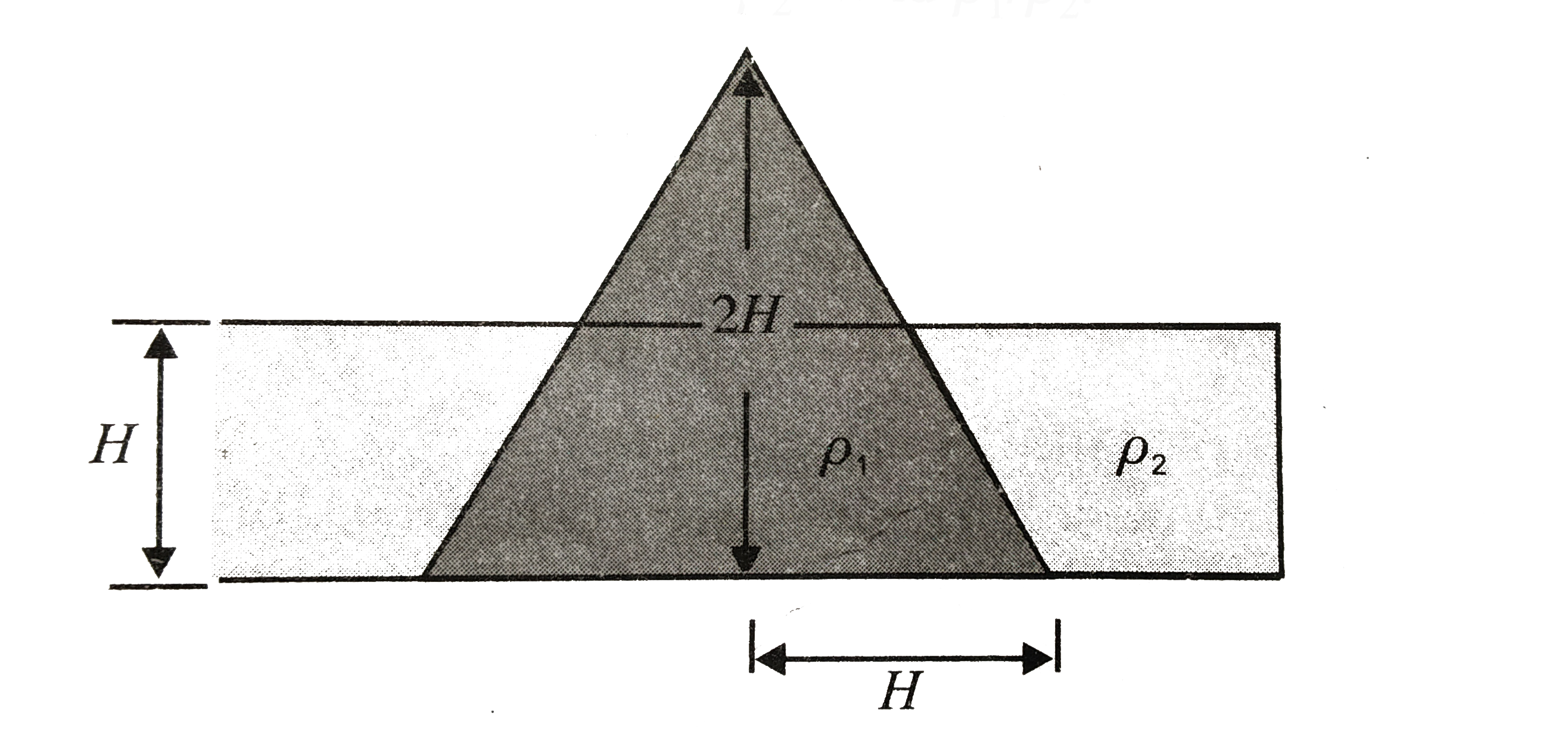Two small spherical metal balls, having equal masses, are made from materials of densities and have radii 1 mm and 2mm respectively, they are made to fall vertically (from rest) in a viscous medium whose coefficient of viscosity equal and whose density is 0.1 . The ratio of their terminal velocities would be
The correct Answer is:A
To find the ratio of the terminal velocities of the two spherical metal balls falling in a viscous medium, we can follow these steps:
Step 1: Understand the formula for terminal velocity
The terminal velocity Vt of a sphere falling through a viscous fluid is given by the formula:
Vt=29r2g(ρs−ρl)η
where:
- r = radius of the sphere
- g = acceleration due to gravity
- ρs = density of the sphere
- ρl = density of the liquid
- η = coefficient of viscosity of the liquid
Step 2: Define the parameters for both spheres
Let:
- Sphere 1 (radius r1=1mm=0.001m, density ρ1=8ρ2)
- Sphere 2 (radius r2=2mm=0.002m, density ρ2)
- Density of the liquid ρl=0.1ρ2
Step 3: Calculate the terminal velocities for both spheres
Using the formula for terminal velocity, we can write:
1. For Sphere 1:
Vt1=29(0.001)2g(8ρ2−0.1ρ2)η
=29(0.001)2g(7.9ρ2)η
2. For Sphere 2:
Vt2=29(0.002)2g(ρ2−0.1ρ2)η
=29(0.002)2g(0.9ρ2)η
Step 4: Simplify the expressions
Now, we simplify both expressions:
1. For Sphere 1:
Vt1=29(0.000001)g(7.9ρ2)η
2. For Sphere 2:
Vt2=29(0.000004)g(0.9ρ2)η
Step 5: Take the ratio of terminal velocities
Now, we can find the ratio Vt1Vt2:
Vt1Vt2=29(0.000001)g(7.9ρ2)η29(0.000004)g(0.9ρ2)η
The 29, g, and η cancel out:
=0.000001⋅7.9ρ20.000004⋅0.9ρ2
The ρ2 also cancels out:
=0.000001⋅7.90.000004⋅0.9
Step 6: Perform the calculations
Calculating the above expression:
=7.90.000004⋅0.9=7.90.0000036=790.036=79×100036=7900036≈2194.44
Final Result
The ratio of the terminal velocities Vt1Vt2 is approximately 2194.44.
The terminal velocity Vt of a sphere falling through a viscous fluid is given by the formula:
- r = radius of the sphere
- g = acceleration due to gravity
- ρs = density of the sphere
- ρl = density of the liquid
- η = coefficient of viscosity of the liquid
Let:
- Sphere 1 (radius r1=1mm=0.001m, density ρ1=8ρ2)
- Sphere 2 (radius r2=2mm=0.002m, density ρ2)
- Density of the liquid ρl=0.1ρ2
Using the formula for terminal velocity, we can write:
Vt1=29(0.001)2g(8ρ2−0.1ρ2)η
=29(0.001)2g(7.9ρ2)η
Vt2=29(0.002)2g(ρ2−0.1ρ2)η
=29(0.002)2g(0.9ρ2)η
Now, we simplify both expressions:
Vt1=29(0.000001)g(7.9ρ2)η
Vt2=29(0.000004)g(0.9ρ2)η
Now, we can find the ratio Vt1Vt2:
Calculating the above expression:
The ratio of the terminal velocities Vt1Vt2 is approximately 2194.44.
Topper's Solved these Questions
- MECHANICAL PROPERTIES OF FLUIDSBOOK - MODERN PUBLICATIONCHAPTER - MECHANICAL PROPERTIES OF FLUIDSEXERCISE - Competition File (JEE (Main) & Other State Boards For Engineering Entrance)
23 Videos
- MECHANICAL PROPERTIES OF FLUIDSBOOK - MODERN PUBLICATIONCHAPTER - MECHANICAL PROPERTIES OF FLUIDSEXERCISE - Competition File (JEE (Advanced) For IIT Entrance)
14 Videos
- MECHANICAL PROPERTIES OF FLUIDSBOOK - MODERN PUBLICATIONCHAPTER - MECHANICAL PROPERTIES OF FLUIDSEXERCISE - Competition File (A. MCQ (Objectie Type Questions))
20 Videos
- MATHEMATICAL TOOLSBOOK - MODERN PUBLICATIONCHAPTER - MATHEMATICAL TOOLSEXERCISE - PRACTICE PROBLEMS (10)
12 Videos
- MOTION IN A PLANE BOOK - MODERN PUBLICATIONCHAPTER - MOTION IN A PLANE EXERCISE - Chapter Practice Test
15 Videos
Similar Questions
Knowledge Check
Two circular discs A and B have equal masses and uniform thickness but have densities ρ1 and ρ2 such that ρ1>ρ2 . Their moments of inertia is
AI1>I2BI1>>I2CI1<I2DI1=I2The escape velocities of the two planets, of densities ρ1 and ρ2 and having same radius, are v1 and v2 respectively. Then
Av1v2=ρ1ρ2Bv2v1=ρ2ρ1Cv1v2=(ρ1ρ2)2Dv1v2=√ρ1ρ2Two wires of equal diameters, of resistivities ρ1 and ρ2 and length l1 and l2, respectively of the combination is
Aρ1l1+ρ2l2l1+l2Bρ1l2+ρ2l1l1−l2Cρ1l2+ρ2l1l1+l2Dρ1l1+ρ2l2l1−l2
Two solid spheres are made up of the same material of density ρ. The ratio of their radii is 1:2. The ratio of their moments of inertia about their respective diameters is
View SolutionTwo discs have same mass and thickness. Their materials are of densities ρ1 and ρ2 . The ratio of their moment of inertia about central axis will be
View SolutionTwo disc has same mass rotates about the same axis with their densities ρ1 and ρ2 respectively such that (ρ1>ρ2), then the relation between I1 and I2 will be
View SolutionTwo wires of equal diameters of resistivies ρ1 and ρ2 and lengths l and l respectively are joined in series. The equivalent resistivity of the combination is
View SolutionTwo circular disc of same mass and thickness are made from metals having densities ρ1 and ρ2 respectively. The ratio of their moment of inertia about an axis passing through its centre is,
View Solution

